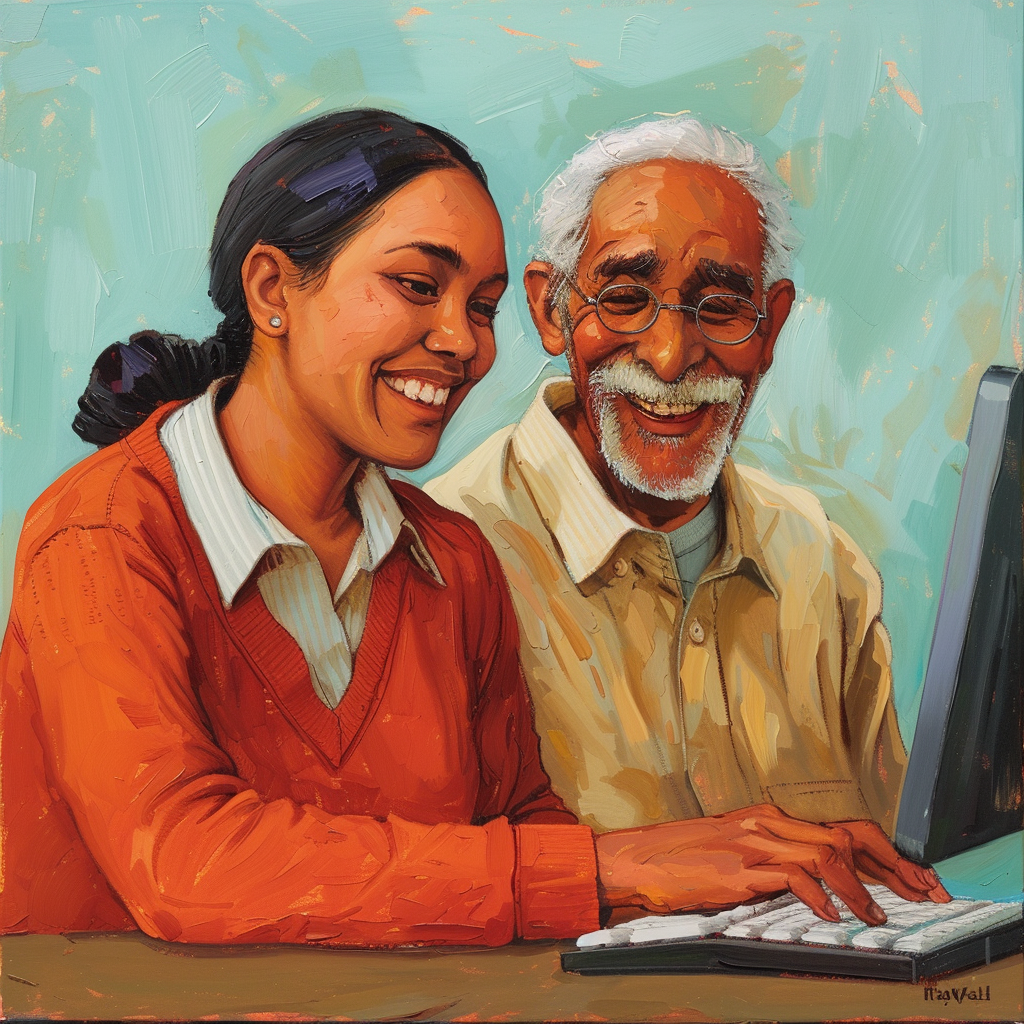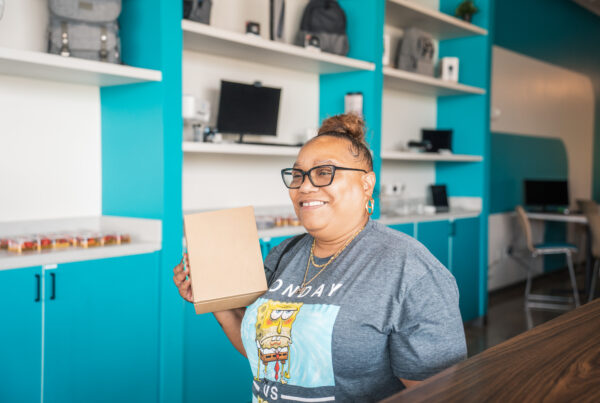In 2024, a stark reality persists: over 100 million Americans remain disconnected or underconnected from the digital world. This chasm, known as the digital divide, isn’t just about missing out on cat videos or social media trends. It’s a formidable barrier to education, employment, and essential services.
Imagine a mother, smartphone in hand, struggling to help her children with homework. Picture a job seeker, forced to navigate the labyrinthine process of online applications without a computer. For millions, this isn’t a hypothetical scenario—it’s their daily existence.
But bridging this divide requires more than just distributing devices or establishing Wi-Fi hotspots. It demands a holistic approach that empowers individuals with the skills and confidence to navigate our increasingly digital landscape. Enter the digital navigators: tech-savvy guides who serve as catalysts for change.
Erin Carr-Jordan, CEO of the Digital Equity Institute, puts it succinctly: “Digital Navigators are the catalyst for building trust with community.” These front-line warriors don’t just connect people to the internet; they help them thrive in the digital realm.
Why does this divide stubbornly persist? And how can we effectively combat it? The answers lie in understanding the complex tapestry of challenges and exploring innovative solutions. Digital navigation isn’t just a buzzword—it’s emerging as a game-changing strategy in our quest to bridge the digital gap.
Table of Contents
- Understanding the Digital Divide
- The Role of Digital Navigation in Bridging the Gap
- The Impact of Digital Navigation Programs
- Human-I-T’s Gold Standard of Digital Navigation Services: Connecting the Dots
- Scaling Digital Navigation: Challenges and Opportunities on the Horizon
- Support Human-I-T, Support Digital Navigation
- Contact us to learn how you can support our digital navigation work
Understanding the Digital Divide
The digital divide—a chasm between the connected and the disconnected—runs deeper and wider than many realize. As defined by the National Digital Inclusion Alliance, it separates those who can harness digital technologies from those left behind in our increasingly online world.
A 2020 US Census report reveals a troubling pattern: low-income, Black, Hispanic, and rural populations bear the brunt of this digital exclusion. The disparity becomes even more pronounced on a global scale. While Europe boasts an impressive 89% internet penetration, Africa lags far behind at a mere 40%. Even within the United States, a glaring urban-rural divide persists, with city dwellers twice as likely to have internet access as their rural counterparts.
But the digital divide is far more complex than simply having—or lacking—an internet connection. It’s a three-headed beast, each head representing a formidable challenge:
- Availability: In many rural areas, high-speed internet remains a pipe dream. It’s akin to standing before a water fountain in a desert—the infrastructure simply doesn’t exist.
- Affordability: For countless families, the choice between putting food on the table and paying for internet access is all too real. The cost of devices and monthly bills creates an insurmountable barrier for many.
- Adoption: Even when internet is both available and affordable, a lack of digital literacy can leave individuals stranded. It’s like owning a car without knowing how to drive—the potential for mobility exists, but remains frustratingly out of reach.
These barriers compound and reinforce each other, trapping people in a cycle of digital exclusion. The consequences ripple through every aspect of life, from limited educational opportunities and job prospects to restricted access to healthcare and essential services.
Addressing this multifaceted problem requires more than a one-size-fits-all solution. We need a nuanced, community-driven approach that recognizes and addresses the unique challenges faced by those on the wrong side of the digital divide. Only through personalized strategies can we hope to bridge this gap and ensure that the benefits of our digital age are accessible to all.
The Role of Digital Navigation in Bridging the Gap
In the quest to close the digital divide, a powerful, personalized approach has emerged: digital navigation. This innovative strategy is akin to having a tech-savvy confidant by your side, guiding you through the intricate maze of the digital world with patience and expertise.
How digital navigators address unique challenges
Digital navigators are the unsung heroes of this technological revolution. Far more than mere IT specialists, they are community champions who intimately understand the hurdles faced by those left in the digital dust. These dedicated individuals tackle the divide on three crucial fronts:
- Tech Access: Gone are the days of simply pointing someone towards a computer. Digital navigators act as personal tech recommenders, helping individuals find devices that not only fit their needs but also their budgets. They transform the daunting task of technology acquisition into a tailored, accessible experience.
- Skill-Building Bootcamps: Forget dry, incomprehensible manuals. Some navigators can offer immersive, hands-on training that transforms digital novices into confident users. From the basics of email setup to the intricacies of online job applications, they provide comprehensive support that empowers users to navigate the digital landscape with ease.
- Resource Matchmaking: In a world overflowing with digital resources, finding the right ones can be overwhelming. Digital navigators serve as human search engines, connecting individuals to a wealth of opportunities they might never have discovered on their own. Whether it’s locating affordable internet options or identifying relevant online courses, these guides open doors to a world of digital possibilities.
By addressing these key areas, digital navigators do more than just bridge the technical gap—they empower individuals to fully participate in our increasingly digital society. Their work is not just about connecting people to the internet; it’s about connecting them to opportunities, education, and a brighter future.
The Impact of Digital Navigation Programs
Digital navigation initiatives are transforming lives in tangible ways. Both data and personal experiences paint a vivid picture of their effectiveness, reminding us that providing devices and internet connectivity is merely the first step in a broader mission.
The Numbers Don’t Lie: Digital Navigation’s Measurable Impact
A Boston Consulting Group study reveals striking results: over 65% of participants working with digital navigators gained home internet or device access. Even more remarkably, 85% of these individuals now engage with online resources more frequently.
This success story doesn’t end there. The same research found an impressive 80% satisfaction rate among users, highlighting the effectiveness of personalized guidance.
The ripple effects extend far beyond basic connectivity. According to a 2020 US Census report, nearly one-fifth of Americans still lack broadband access or an internet-capable device. Digital navigation programs actively bridge this chasm. Take Human-I-T, for instance: our digital inclusion initiatives – enhanced by digital navigation – have connected over 110,000 households to the internet.
Additionally, these programs tackle the skills gap head-on. Human-I-T’s training initiatives have equipped more than 11,000 individuals with crucial tech literacy, preparing them for an increasingly connected world.
Real People, Real Stories: The Human Side of Digital Navigation
Behind every statistic lies a life changed. Consider JoBeth, a mother of five working towards her GED: “I’m grateful for this program teaching me the basics of using technology” (World Education, Inc.). Her journey showcases how digital navigation bridges both technological and educational divides.
Farzana, a digital navigator herself, sheds light on another vital aspect: “Many older students struggle with tech access, requiring an introduction to fundamental principles” (World Education, Inc.). Her multilingual approach demonstrates how this work spans generational and cultural boundaries.
Economic and Societal Empowerment Through Digital Access
The economic advantages are also substantial. Nearly half of those assisted by digital navigators reported improved healthcare access. Over 40% received aid with essentials like food and housing. Perhaps most significantly, more than one in three secured new employment or boosted their income.
The societal benefits are equally striking. Ecotone Analytics reports that every dollar invested in digital access yields a projected $2.40 in societal value. This translates to enhanced economic growth and reduced social service expenditures. Ultimately, it means more job opportunities and improved access to essential goods and services.
As technology evolves at breakneck speed, digital navigators become increasingly vital. They’re not simply providing access; they’re empowering individuals to fully engage in our connected society. The outcome? A more equitable, skilled, and united community, well-equipped to face future challenges and seize emerging opportunities.
Human-I-T’s Gold Standard of Digital Navigation Services: Connecting the Dots
Human-I-T’s Holistic Approach to Digital Inclusion
At Human-I-T, we’ve embraced a comprehensive view of digital navigation. Our mission extends beyond providing hardware or internet access; we address the entire spectrum of an individual’s tech needs. As a nonprofit, we strive to create equitable opportunities by offering devices, connectivity, skills training, and support to underserved communities.
Our navigators form the backbone of this initiative. While they possess technical expertise, their true strength lies in their empathy and ability to guide each person towards resources tailored to their unique circumstances.
Take one of our digital navigators, Maggs, for instance. She went the extra mile to make sure Human-I-T member Sandra Warshaw’s internet wasn’t interrupted. Sandra reports, “I am so grateful to Maggs for helping to make sure everything went smoothly! I thought I had reached the limit of gratitude but apparently not! At this point my gratitude to Human-I-T is beyond the moon to the outer galaxies!”
And read how Human-I-T’s Digital Navigation program impacted member, LaTonya Brooks. “Human I-T has been helping to open educational doors for my son, as the hot spot is used for his online classes. Human I-T has made a tremendous difference in my son’s access to educational opportunities. I greatly appreciate their outstanding support!”
Our Four-Step Process: From Assessment to Achievement
- Understanding Needs: We begin with a thoughtful assessment, gauging each individual’s situation and comfort level with technology.
- Tailored Solutions: Based on this evaluation, we recommend suitable devices and services, including affordable internet options, literacy training, and technical assistance.
- Active Support: Rather than simply offering directions, we actively assist in applying for and setting up necessary services.
- Ongoing Guidance: Our commitment extends beyond initial setup. We monitor progress, conduct follow-ups, and address any emerging challenges to ensure continued success.
Beyond Connection: Building a Future of Digital Equity
Human-I-T’s distinction lies in our unwavering commitment to long-term progress. We don’t just connect; we cultivate. Our persistence ensures individuals advance towards their tech goals, from helping seniors connect with family to guiding job seekers through their first email setup.
Our mission transcends mere connectivity. We’re fostering links between people, opportunities, and a future where digital equity is the norm. Obstacles persist, but the potential rewards are immense. Each empowered individual represents a step towards a more inclusive, connected world.
Scaling Digital Navigation: Challenges and Opportunities on the Horizon
Funding the Future: Ensuring Sustainable Impact
Digital navigation programs have proven their worth, but keeping them running is no small feat. The financial puzzle is complex: while initial funding often comes from grants or pilot programs, sustaining these initiatives long-term requires creative solutions. Some organizations are exploring public-private partnerships, while others are integrating digital navigation into existing budgets for social services.
The key? Demonstrating return on investment. When stakeholders see the tangible benefits—improved education outcomes, increased employment rates, better health management—they’re more likely to keep the funding flowing.
A great example of this is the San José Digital Inclusion Fund. This public-private partnership disburses up to $1 million each year to organizations closing the digital divide, including those offering digital navigator programs. They pay $350 to community groups for each successful broadband adoption, defined as an individual having an internet connection at home, a digital device, and basic digital skills.
Breaking Through the Noise: Raising Awareness in a Digital World
Ironically, those who need digital navigation services the most are often the hardest to reach through traditional outreach methods. How do you inform someone about online resources when they’re not online? This challenge calls for grassroots efforts and community partnerships. Successful programs are leveraging trusted local institutions—libraries, community centers, places of worship—to spread the word. They’re also tapping into existing social networks, recognizing that word-of-mouth remains a powerful tool, even in our digital age.
Christa Vinston of Rural LISC provides a concrete example of innovative outreach: “We trained a fire station and a cultural heritage center to make referrals to the Digital Navigator program in a rural community to reach more people.” This approach leverages existing community trust to bridge digital divides. Additionally, the success of activation campaigns like health care enrollment and voter registration offers valuable lessons for digital navigation outreach.
Support Human-I-T, Support Digital Navigation
As we’ve explored, digital navigation is successful because it prioritizes outcomes above all. From boosting economic opportunities to enhancing access to education and healthcare, the impact of digital navigators ripples through every aspect of modern life.
But the journey doesn’t end here. The digital landscape is ever-evolving, and so must our efforts to ensure no one is left behind. Whether you’re a community leader, a tech professional, or simply someone who believes in digital equity, there’s a role for you in this vital mission.
Join Human-I-T in our mission to bridge the digital divide by supporting our digital navigation work.






